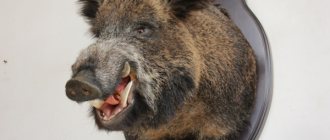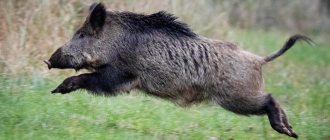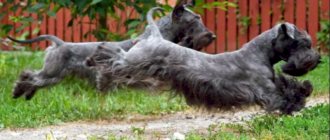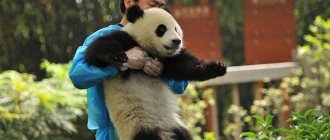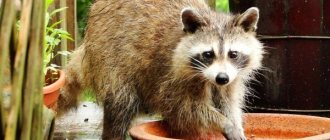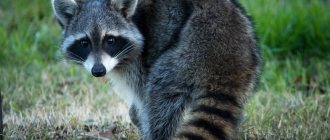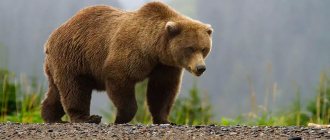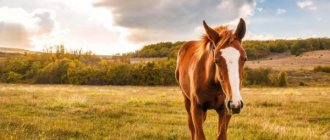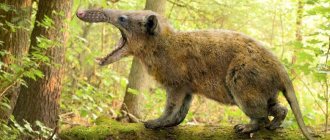Home page Wildlife Animal world
70 783 4.7 14
Once upon a time, back in ancient times, the striped raccoon was a person. Moreover, he was quite resourceful and cunning - he deceived everyone all the time, cheated, and also stole everything that was in bad shape, since he had an irresistible addiction to kleptomania. He went so far as to anger the Supreme Spirit to such an extent that he rashly turned him into a raccoon. Some time later, he relented and returned human hands to the animal, the same as before, fast and dexterous.
Perhaps this is why the Indians do not eat this animal, fearing that through food the moral qualities of the raccoon will also be passed on to them, which are far from honorable characteristics among proud Indians.
There are seven species of raccoons
All raccoons are native to North and Central America. Their species vary only slightly in size and color. The North American striped raccoon is the most common species. It covers a huge range that includes southern Canada, most of the United States and parts of northern South America. Most other species live in tropical areas. During the 20th century, raccoons were introduced to other parts of the globe. Introduced species are now widely represented in countries such as Germany, the Russian Federation and Japan.
How to complete the task?
Here you will find a simple text + translation + video, where the text is read twice - with and without subtitles. Here's how I recommend using these materials:
- Read the text and translation. With the help of translation you will learn the meaning of unfamiliar words.
- Watch the video. It consists of two parts.
- Step 1. Listen and read. Listen to the audio and read the text.
- Step 2. Listen. When you are already familiar with the text, listen to the audio without the text and try to hear everything that is said.
If you immediately listen to the audio without text, much will be unclear. But if you first read the text, translation, watch a video with subtitles, then the speech will be perceived much easier.
The raccoon's coloring is ideal for nocturnal animals.
Photo: Joshua J. Cotten
Raccoons' thick fur is grayish-brown, and the tail has five to seven thin dark rings alternating with wider gray or brown rings. The tip of the tail is always dark. All raccoons have "bandit" masks on their faces - large black markings around each eye. The black “mask” extends from the edge of the nose to the bottom of the cheek. They also have whitish spots on the top of the eyes and around the nose. Raccoons have round ears edged with white fur. They have very dexterous front paws and are known to pick locks and reach into trash cans for food. Raccoons are excellent climbers, but not very fast swimmers.
Where to keep a pet raccoon?
The ideal housing option for a fluffy is a separate room.
The room needs to be specially adapted for the life of this masked sneak:
- There should be no wires plugged into the room (raccoons chew the wire and receive a fatal electric shock)
- Remove valuable equipment, furniture and expensive decorative elements
- Set up a playground like a mini town, with a wall bars, monkey bars, various crossbars, bridges, etc.
- Equip the room with a drinking bowl and feeder so that you can care for the raccoon
- Place a litter tray
- The raccoon's room must be locked
- It is highly not recommended to have a raccoon in a house where there are small children. The fact is that the gargle will not tolerate being treated like a toy. And it’s difficult to explain to a child that even a pet furry is at heart a wild and very, very dangerous animal.
You must always remember that raccoons should never be left unattended alone at home, when these wonderful animals have access to all rooms. The rinsers easily unscrew gas valves on kitchen stoves, chew through PVC water pipes and expose the insulation on live wires.
If it is not possible to allocate a whole room to the raccoon, then you need to set up an isolated enclosure where the miracle with a striped tail will spend the night and while away the time when the owners are not at home. It is better to make the enclosure more spacious so that the animal does not feel particularly cramped and to make it easier to care for the striper.
Some owners of minke whales arrange housing for these charming weasels on the balcony. Of course, during winter the temperature of the loggia atmosphere should not fall below +12° (C), and in summer the balcony should be well ventilated.
Their home is where the water is
Being a highly adaptable species, the raccoon lives wherever there is water. These furry bandits are found in swamps and farmlands, prairies, forests, urban and suburban areas adjacent to a water source.
Raccoons rarely set up a den more than a kilometer away from a permanent source of water. Streams and ponds are ideal habitats for raccoons, and in urban and suburban environments they will make dens near fountains, outdoor pools and drains.
Photo: jaimy van kessel
Raccoons are most active in the early evening and at night; they are rarely active during the day. However, when raccoons are in dire need of food, they leave the den during daylight hours. But in any case, they do not stray far from their home.
During the day, mammals take shelter in hollow trees, rock crevices, nests or burrows of other animals, and in warm weather they often find protected places to rest on the ground. Where raccoons have adapted to living in populated areas, they often take up residence in attics, chimneys and crawl spaces.
Habitat
Usually the raccoon’s home is located near the water, having chosen a hollow in a suitable tree - usually the diameter of the entrance to its new home is from 12 to 19 cm and is located 30 cm from the ground. It is not difficult to find a raccoon’s house: the bark on the trunk of such a tree is very scratched and you can see a lot of hairs on it.
In addition to the main habitat, the raccoon has several other shelters, just in case, but still prefers to sleep in the main one.
If there is no suitable hollow nearby, it is quite capable of settling in a crevice between stones, between fallen tree trunks and even in a pile of brushwood. Or it can crawl underground, finding a suitable abandoned hole (for example, badgers), since raccoons do not know how to dig them on their own.
The raccoon is extremely adaptable, so often the raccoon’s home is located near some populated area, in orchards or even in a park, of course, if they like it there. At the same time, having chosen a territory, he rarely moves more than 1.5 km away from it - and even then, very compelling reasons are needed for this.
The only places where you are unlikely to find a raccoon home are coniferous forests, as well as places where there are few bodies of water. These animals also do not like regions with very harsh winters.
Raccoons are omnivores
Photo: www.businessinsurance.com
They catch most of their food in the water. These nocturnal foragers use their lightning-fast claws to grab fish, shellfish, snails, frogs, crustaceans and other aquatic creatures. In the spring and early summer season, they also include small mammals, insects, rodents, small birds, bird eggs, carrion and even turtles in their diet. In late summer, raccoons tend to consume more plant material such as tubers, seeds, berries, grains, nuts, fruits and plants. In the fall, raccoons stock up on fatty nuts and seeds for the coming winter.
Raccoons are not very picky eaters. They sometimes raid trash containers, pet feeders, and human supplies. Maybe that's why raccoons have earned a reputation as bandits? Although what is more remarkable is that they rinse all the food they find in the nearest water source.
Nutrition
Despite the fact that raccoons are carnivorous animals, in reality they are omnivores, since they do not disdain plant foods.
In spring and early summer, the raccoon prefers to eat animal food. To do this, he, having descended from the trees in search of food, moves slowly, often stopping and looking for something edible on the ground. Reacts instantly to living small creatures. Having made several jumps and caught up with the victim, he grabs the prey and eats it with appetite, purring and slurping as he does so.
During drought, when their main food (frogs and crayfish) is rare, raccoons do not disdain mouse-like rodents, beetles, they are able to catch and eat a snake, collect bird eggs, eat chicks, and can even climb into a chicken coop.
In water, this animal hunts somewhat differently, since it is very difficult to see or smell prey in the dark, one might even say problematic. Therefore, the hunt proceeds as follows:
- The raccoon puts its paws into the water and moves them along the bottom, examining not only the soil, but also the snags;
- In the end, his hypersensitive fingers push on the prey and instantly grab it, rinsing it at the same time. Raccoon raccoons do this especially carefully;
- They not only wash the prey, but also determine its exact properties. In the water, its fingers are much more sensitive than outside, so they help it accurately determine whether the prey is edible and ready to eat. For example, if a raccoon manages to catch a crayfish or a crab, he pulls the catch out of the water, hits it against the rocks with all his might, and then puts it back into the water to determine whether the prey is alive or not.
At the end of summer and beginning of autumn, this animal prefers plant foods - mainly berries, fruits, nuts, and acorns. Since raccoons do not avoid visiting human settlements, they often visit gardens, orchards, and fields. If this or that year fruits and berries yielded a bad harvest, they will not disdain grains. In search of something tasty, they are quite capable of rummaging through the trash bin.
Their Latin name "lotor" means "gargle"
In addition to excellent night vision and acute hearing, raccoons have sensitive front paws. Having four times more tactile receptors on their front legs, they are able to sense food underwater and in the dark. In the absence of water, raccoons will move food through sand or snow before eating it. However, contrary to popular belief, raccoons do not wash their food to clean it. They are just used to getting food under water and they “pleasant” to feel it on their very sensitive paws.
Raccoons do not have opposable thumbs, and in fact their front paws are not like those of humans or primates. They are shaped like the paw of a weasel or ferret, but they do not have webbing between their front toes. The palms of the front paws are protected by a thin layer of horny skin, which becomes soft and pliable when wet.
Photo: www.foxnews.com
The little finger and thumb are offset from the middle three fingers and can meet in the middle of the palm, allowing the raccoon to grasp and manipulate objects with reasonable strength and exceptional dexterity. Raccoons can unscrew cans, undo locks, and even untie knots. And the joints of their hind legs can rotate 180 degrees, allowing them to climb down tree trunks headfirst.
Appearance
The appearance of predatory mammals resembles raccoon dogs. The animals have a stocky body, short legs, long fingers with claws. The back of the paw does not contain hair. When a raccoon stops, it rests on its entire sole; while moving, the main emphasis is on its fingers, so the pet’s tracks resemble a human hand.
Large head, short, sharp muzzle, small rounded ears. The entire body is covered with fluffy, long fur. It is noteworthy that the location of the fur on the sides of the head resembles sideburns. A raccoon's mouth can have between 36 and 42 teeth.
Since the raccoon loves to swim and spends a lot of time in water, the fur consists of thick undercoat, which makes up 90% of the total.
The yellowish-gray color of the animal includes black hairs. A black-brown stripe is clearly visible on the muzzle, located from the tip of the nose to the forehead. The area around the eyes is decorated with spots of a similar color.
The tail is unique; wide gray-yellow or black-brown rings are located parallel to each other over the entire surface. Males differ from females in their large size.
Females give birth to cubs once a year
Males and females become reproductively mature at approximately one year of age; however, most males wait another year to breed because they are in strong competition with larger, older males. Mating season for raccoons typically occurs between January and June, depending on environmental conditions. In the northern regions, the peak mating season is from January to the end of March.
Since the male exhibits aggressive behavior towards the young, the female tolerates his presence only during mating and raises the young on her own. The gestation period is 63-65 days. Before giving birth in April or May, the female builds a nest, often using a tree hollow, chimney, or other cavity.
Reaction to strangers and unfamiliar surroundings
Raccoons do not like guests, especially those whom they have never seen. There are often cases when the pet owner does not care for the animal and tries to transfer the pet “in good hands.” Such an exchange will be a strong blow for the raccoon.
These creatures have difficulty and take a long time to get used to a foreign atmosphere, to foreign rules and habits. If we talk about exchanging a completely adult fluffy, then such a creature will never be able to be re-tamed.
And if you put a raccoon out the door, then such a step will be tantamount to death. Domesticated animals do not take root in the wild after a long stay at home.
A litter usually contains two to seven babies
On average, there are four cubs in a litter. At birth they usually weigh 85-140 grams. Their fur is very light and light with barely visible rings on the tail and a mask on the face. The cubs open their eyes at about three weeks of age and begin to try solid food at seven weeks of age. At two months, they already accompany their mother on her nightly forays, gradually learning to find food. By five months, raccoons are able to hunt mice or birds on their own.
Photo: Shutterstock
The young remain with their mother during the first winter and leave her the following spring (when the female is ready to breed again). Although young females sometimes remain in close proximity to their mother and may continue to live with her new litter in the same den. Young males sometimes form small bachelor groups, but in general their social structure is fairly loose with overlapping territories.
Reproduction
Polygamous raccoons try to impregnate as many females as possible during the rut. The mating season takes place during the cold season. Having impregnated one female, the gentleman immediately goes in search of a new lady of his heart.
The courtship does not last long. The male holds a twig in his front paws and rubs his head against it, scratching the ground, thus attracting an individual of the opposite sex.
The fact that the female is ready to mate is indicated by her specific smell. Only females care for the offspring; there is very little hope for gentlemen.
The female carries 4 to 5 cubs for a little over 2 months. Shortly before giving birth, she becomes overly aggressive. Completely helpless babies are born. The cubs weigh only 75 g and are born blind and deaf. Only towards the end of the first month of life do the cubs begin to distinguish objects. At first, newborns feed only on mother's milk. With the appearance of baby teeth, solid foods are introduced into the diet.
Babies are born naked, immediately begin to grow hair, and small black and white spots appear on their faces.
The babies are very voracious; the female feeds her cubs at least 24 times a day.
Communication between babies and mother occurs in a unique language that only they understand. More often the cubs squeak and the mother purrs or grumbles. With age, the voice becomes quieter. By autumn or winter, the cubs grow up and set off to conquer their territories.
Raccoons are constantly vigilant
The main enemies of raccoons are coyotes, wolves, bobcats, foxes, hawks and even owls. Individuals tend to avoid most predators by resting during the day in their dens or hiding in high branches, safely out of reach of at least some of their opponents.
If necessary, raccoons can accelerate up to 25 km/h. However, they will not be able to swim away from a waterfowl predator, since they do not have “waterproof” fur; When wet, the fur becomes heavy and limits movement.
How to raise a raccoon: to bite or not to bite
Raccoons are very tactile creatures. Therefore, it is incredibly important for them to touch everything and taste it. The raccoon receives about 80% of information through direct contact: paws and teeth. Therefore, it is impossible to deprive a raccoon of the opportunity to explore the world through bites. It's like telling you to use your smartphone hands-free. The raccoon also communicates with us through its bites. Since the raccoon cannot say something, it uses bite to declare love, resentment, and other strong emotions. It is impossible to stop a raccoon from biting, but you can teach it to control the force of its bite.
When the baby raccoon grows up and begins to pester his mother, she tugs at his ear, showing that they need to bite each other more tenderly. This is one of the first and most effective ways. If your raccoon bites a lot, you can scratch his ear. Nuances: it is better to do it with your mouth rather than with your hand. It only works when the raccoon enters puberty. It won't work with adults, because... he has already formed biting norms.
Another way to teach control over bite force is to stick your finger in the raccoon's mouth while biting. Not across the fangs, but right inside the mouth. At this moment, the raccoon’s reflexes kick in and it stops biting. Over time, the raccoon will understand that this action follows a strong bite. Nuances: again, only in youth. It is also necessary to insert your finger only at the moment of strong bites, otherwise the raccoon will not connect these actions in its head.
The next method is when the raccoon is allowed to bite painfully only in certain clothes. Face it, the raccoon will still bite you. You can explain to him that you are hurt. And when you are in special protection, he can bite you as much as he wants. It will be very pleasant to play with a raccoon: the raccoon is happy and it doesn’t hurt you. Nuances: you cannot change biting clothes, and there is not a single piece of clothing in which you will be truly comfortable.
Some people use the method of blowing into the raccoon's nose or spraying it from a spray bottle. But usually these methods are not so effective, are temporary, and sometimes even anger the raccoon even more. Raccoons need to bite you, let the raccoon be a raccoon, just teach it to do it more gently.
Did you know?
- The word raccoon comes from the Native American word "powhatan", meaning "an animal that scrapes with its hands."
- Research has shown that raccoons are far superior to dogs and cats at solving mazes and have primate-level problem-solving skills.
- The lifespan of a raccoon depends on whether it lives in the wild or in captivity. Wild individuals can live 15 years, but they usually do not live past the age of five. In zoos, environmental centers, or as pets, raccoons live for 20 years.
- In the Russian Empire they were called "genots" because of their resemblance to genets, predatory mammals with long striped tails.
Interesting facts about raccoons
Always restless, curious and hyperactive, raccoons are creatures beloved by many. They are even kept as pets, although it must be admitted that this is not an easy task. There are no places in the house where a bored raccoon could not get, and at the same time, locking all the drawers and doors is not only useless, but even cruel - because of the inability to get where they want, raccoons become hysterical, sometimes then turning into depression. So it’s better to think three times before bringing such an animal into your home.
Facts about raccoons
- These animals are not particularly afraid of people, and often climb into houses to steal something edible there.
- Initially, raccoons were found only in the New World, but researchers brought the striped raccoon to Europe. This species has taken root well in the vastness of Eurasia.
- From a zoological point of view, raccoons are distant relatives of bears (interesting facts about bears).
- After the birth of the cubs, the female feeds them with milk several times an hour, up to 20-25 times a day, with short breaks for sleep.
- Cubs are born deaf and blind. These feelings appear in them only around the third week of life.
- On the paws of raccoons there are extremely sensitive receptors that are able to provide the animal with complete information about the object being touched, even if it does not look at it. That’s why raccoons love to touch and twirl in their paws everything that comes their way.
- The gargle raccoon earned its name for its tendency to rinse everything in water.
- Their hind legs are incredibly flexible - the joints on them can bend 180 degrees.
- Unlike most other mammals, a raccoon, having climbed a tree, can fearlessly climb down headfirst.
- Female raccoons always have spare holes, where in case of danger she can urgently transfer the cubs. Sometimes they have ten or even more such backup shelters.
- Raccoons often live in tree hollows or between their roots. They do not dig holes, but willingly occupy empty ones dug by someone else.
- Thanks to sensitive whiskers that can sense the slightest breath of wind, and excellent night vision, raccoons can run at top speed even in complete darkness, without fear of crashing into something and getting hurt.
- A raccoon that finds itself in a hopeless situation often pretends to be dead, hoping that the predator will disdain the carrion.
- Like cats, raccoons can jump from great heights and land softly. Cases have been reliably recorded when they jumped from a height of more than 10 meters without harm to themselves (interesting facts about cats).
- In captivity they can live more than 20 years, but in the wild their average lifespan is usually half that.
- It is not easy to survive in winter, and raccoons stock up on food and also huddle in groups to keep it warmer. Sometimes up to a dozen individuals can spend the winter in one burrow.
- Raccoons that live in warm regions do not hibernate, but those that live in the north usually sleep all winter. True, their sleep is extremely sensitive, and at the slightest sign they immediately wake up, ready to defend themselves or run away.
- These animals are very smart. Those who live at home, for example, usually very quickly learn how water taps work, and easily open them when they want water.
- The star's Latin name, Procyon, means "raccoon" in this ancient language.
- The front paws of raccoons closely resemble human hands.
- These animals are lucky with their immunity - they are not afraid of most diseases. However, they can still carry them.
- Raccoons are not too picky in their taste preferences. Small rodents, birds and their eggs, fruits, berries, leftovers from human meals - they willingly eat everything.
- An adult raccoon can reach a weight of 10-12 kg, which is comparable to the weight of Maine Coons, the largest cat breed.
- After the discovery of raccoons by the expedition of Christopher Columbus, scientists for a long time could not decide which genus to classify them in - bears, cats, dogs or badgers. After a couple of centuries, they were finally identified as a separate genus.
- Before hibernation, raccoons eat to gain fat reserves and gain up to 50-70% of their normal weight. At the same time, they become very thick indeed.
- Raccoons fight only as a last resort, when there is no other choice. They prefer to flee, and if this does not help, they play dead. If this does not deceive the enemy, they begin to defend themselves, and they do it unusually fiercely.
- These animals rarely move far from home or change their place of residence. Having chosen a place for themselves, they usually limit their walks to its immediate surroundings.
- Raccoons of the same species living in the north usually produce more offspring than their counterparts in the south. In total, they usually give birth to 2-5 cubs.
- Like humans, raccoons grow their baby teeth first, and then their molars.
- Raccoons rarely live far from bodies of water because they almost always wash their food before eating it.
How to raise a raccoon: a walk
Many will say that a walk is an important ritual for any pet. But this is not at all necessary for a raccoon. Some raccoons really love to walk: bury themselves in snowdrifts, run through puddles, and climb trees. For others, such outings are sheer stress. If you still want to go for walks with your raccoon, start teaching him to go for walks from an early age. Choose calm, quiet and safe locations. Start with small walks in your arms, then try placing the raccoon on the ground. If the raccoon is ready, then calmly walk with him on a harness. Usually raccoons themselves show when they have had enough time, he will ask to be held.
How to raise a raccoon: veterinarian and tests
The worst thing for any raccoon owner is to have their blood tested. Even if your raccoon is the healthiest in the world, sooner or later, the time will come to get tested. First, try at home fixing a raccoon’s paw in your hand and giving it a treat. Hold your paw as if you are about to draw blood from a vein. When the raccoon is ready, it moves on to the stage with the stick. Now, when fixing, add a small twig, with which you need to lightly poke the raccoon in the paw (as if you are taking blood). Don’t forget to give a treat, we give only one treat and only for a fully completed action. When the raccoon is ready, we switch to a syringe, without a needle, of course. We also squeeze the paw, poke the paw with a syringe - we give it a tasty treat. Using the same scheme, we teach the raccoon not to be afraid of a prick in the withers. Ideally, exercise once a day.
How to raise a raccoon: carrier and harness
You need to start accustoming your raccoon to a harness from a very early age. Put the harness on the raccoon for 10 minutes at first and gradually increase the time. Do this every day and the raccoon will understand that there is nothing scary or dangerous in the process of putting on and taking off, as well as in wearing the harness itself.
If the raccoon needs to be trained to carry, then you need to prove to the raccoon that it is not dangerous. The carrier must be accessible to the raccoon. The raccoon must see it and be able to sit in it. When the raccoon gets inside, give him a treat. When the raccoon understands that he gets a treat every time he sits in the carrier, try telling him the word “carrying” and pointing to it. If the raccoon goes inside, reinforce the result with a tasty treat. If you're not ready yet, continue learning.
